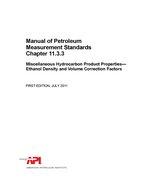No products
 View larger
View larger
API MPMS Chapter 11.3.3
M00042432
New product
API MPMS Chapter 11.3.3 Miscellaneous Hydrocarbon Product Properties - Ethanol Density and Volume Correction Factors
Handbook / Manual / Guide by American Petroleum Institute, 06/01/2011
Full Description
This standard covers density and volume correction factors for pure and denatured fuel ethanol. The actual standard consists of the explicit implementation procedures set forth in this document. Sample tables and other examples created from a computerized version of this implementation procedure are presented as examples only and do not represent the standard.This standard is applicable at any liquid operating temperature to pure (99+ %) ethanol and denatured ethanol containing ASTM D4806 allowed denaturants (natural gasoline, gasoline blend stocks, and unleaded gasoline) in the 2 % to 5 % by volume range.
In stock
More info
Contents
Page
Scope 1
General 1
Limits of Application 1
Normative References 1
Terms and Definitions 1
Implementation Procedures 3
Pure Ethanol 3
Denatured Fuel Ethanol 4
Rounding 5
Data Level 5
Rounding of Numbers 5
Annex A (informative) Ethanol VCF Table Historical Information 6
Annex B (informative) U.S. Regulation of Alcohol for Fuel Use 9
Annex C (informative) Denatured Ethanol Density Study 10
Bibliography 13
Figures
U.S. Customs and Border Protection Directive on Pure Ethanol VCF Table 7
Data and the Applet Output Results 8
Denatured Ethanol Feedstock Densities (0 psig) 11
FS4 Data and the Applet Output Results 12
Tables
1 Signifiacant Digits for Bulk Quantities 5
C.1 Denatured Ethanol Feedstock Densities 10
Table 6C values (x10-6) 12
v
Introduction
Volume Correction Factors (VCFs) are used to correct observed liquid volumes at specific operating conditions to equivalent volumes at a standard temperature condition. The American Petroleum Institute provides procedures for calculating VCFs for generalized crude oils, refined products, lubricating oils, and special applications. These procedures are presented in API MPMS Ch. 11.1-2004/Adjunct to ASTM D1250-04/IP 200/04. The API has not previously addressed ethanol, considered a special application, in MPMS Ch. 11.1, so industry has used a variety of privately developed tables for both pure and denatured ethanol VCFs. The most commonly used table has been that of a large ethanol supplier, and it appears that U.S. Customs and the EPA have adopted a variant of this table. The API, through a consortium of its member companies and in cooperation with the Renewable Fuels Association (RFA), commissioned an independent laboratory to take density measurements at various temperatures of pure ethanol and representative denatured fuel ethanols. The density data were obtained utilizing the best available commercial instrumentation and was then used to develop the VCFs provided in this standard.
vii
Miscellaneous Hydrocarbon Product Properties—Ethanol Density and Volume Correction Factors
Scope
General
This standard covers density and volume correction factors for pure and denatured fuel ethanol. The actual standard consists of the explicit implementation procedures set forth in this document. Sample tables and other examples created from a computerized version of this implementation procedure are presented as examples only and do not represent the standard.
Limits of Application
This standard is applicable at any liquid operating temperature to bulk (e.g. tank trucks, tank cargos, barges) pure (99+ %) ethanol and denatured ethanol containing ASTM D4806 [1] allowed denaturants (natural gasoline, gasoline blend stocks, and unleaded gasoline) in the 2 % to 5 % by volume range.
Normative References
The following referenced documents are indispensable for the application of this document. For dated references, only the edition cited applies. For undated references, the latest edition of the referenced document (including any amendments) applies.
API MPMS Ch. 11.1–2004, Temperature and Pressure Volume Correction Factors for Generalized Crude Oils, Refined Products, and Lubricating Oils (includes Addendum dated September 2007).
API MPMS Ch. 12.1.1–2007, Calculation of Static Petroleum Quantities—Upright Cylindrical Tanks and Marine Vessels.
Terms and Definitions
For the purposes of this document, the following definitions apply.
3.1
absolute density
D
The mass of a substance occupying unit volume at a specified temperature at atmospheric pressure or equilibrium vapor pressure.
NOTE Density as so defined is sometimes referred to as “true density” or as “density in vacuo” or often just plain “density.” When reporting density, the units of mass and volume used and the temperature of the determination have to be stated (e.g. kilograms per cubic meter or grams per millimeter at t °F or (t °C). For the oil industry, if the temperature is unstated, standard temperature (60 °F or 15 °C) should be assumed.
3.2
denaturants
Materials added to ethanol to make it unsuitable for beverage use under a formula approved by a regulatory agency to prevent the imposition of beverage alcohol tax.
3.3
denatured fuel ethanol
Fuel ethanol made unfit for beverage use by the addition of denaturants under formula(s) approved by the applicable regulatory agency to prevent the imposition of beverage alcohol tax.
1

